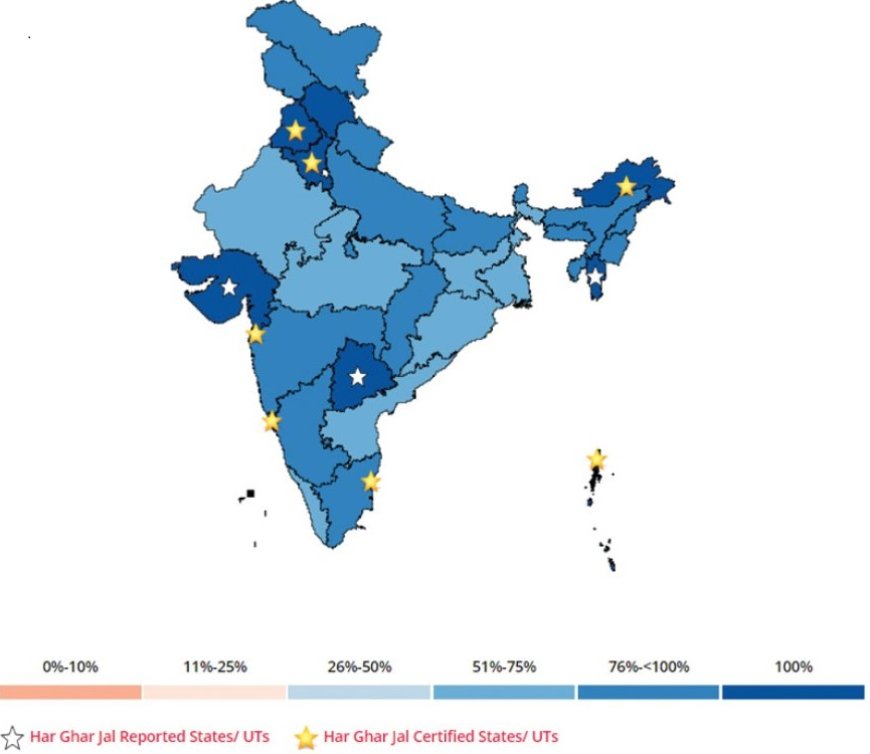The CHALLENGE and the OPPORTUNITY
Water is a fundamental element essential for sustaining life and is vital for the health, progress, and sustainability of any civilization. Its scarcity can undermine social stability, impede economic growth, and disrupt ecological systems.

Water is a fundamental element essential for sustaining life and is vital for the health, progress, and sustainability of any civilization. Its scarcity can undermine social stability, impede economic growth, and disrupt ecological systems. Goal 6 of the United Nations' 2030 Agenda for Sustainable Development specifically aims to ensure universal access to water and sanitation. Despite covering nearly 70% of the Earth's surface, only 3% of the planet's water is fresh, with just 1% being accessible or potable, as the remaining 2% is locked in glaciers and icebergs.
In India, the constitutional right to access clean drinking water is derived from the rights to food, a clean environment, and health, all of which are safeguarded under the broader fundamental Right to Life, as guaranteed by Article 21 of the Constitution. Although India is home to 18% of the global population, it possesses only 4% of the world's freshwater resources, making the management of these limited resources for such a large population a significant challenge.
In an estimate from 2019, it was suggested that USD 238 billion in investments are required to bridge the expected water supply gap by 2030. Under the National Infrastructure Pipeline published by Ministry of Finance, Government of India in April 2020, the water sector (including Jal Jeevan Mission, AMRUT and Irrigation) was given a capital expenditure outlay of USD 233 billion for FY 2020-2025. This manifests the commitment of the Centre and the State Governments of India to cater directly to the challenges being faced in the management of water in the Indian ecosystem.
Central Groundwater Board (CGWB) suggests that sustainable development and efficient management of water resources has become a challenge in India. Increasing population, growing urbanization and rapid industrialization combined with the need for raising agricultural production generates competing demands for water. Ground water has steadily emerged as the backbone of India’s agriculture and drinking water security. Contribution of ground water is nearly 62% in irrigation, 85% in rural water supply and 50% in urban water supply. Ground water is an annually replenishable resource, but its availability is non-uniform in space and time. Ground water available in the zones where water level fluctuates is replenished annually with rainfall being the dominant contributor.
The scarcity of water resources could manifest many cascading effects including desertification, risk to biodiversity, industry, energy sector and risk of exceeding the carrying capacity of urban hubs. It thus becomes necessary for the citizens, the governments, the not-for-profit organizations and the multilateral organizations like the World Bank Group to join hands for developing an ecosystem of efficient water supply, judicious water usage, wastewater treatment for re-use, ground water recharge through water conservation and an effective end to end monitoring of the whole supply chain.
In 2019, Government of India launched its landmark groundwater program, the Atal Bhujal Yojna, to arrest the precipitous decline of groundwater. Since groundwater conservation lies in the hands of hundreds of millions of people, the program placed communities at the heart of the effort, marrying scientific inputs with traditional wisdom to address this complex challenge.
In May 2019, the Government of India merged two water related ministries; Ministry of Water Resources, River Development & Ganga Rejuvenation and Ministry of Drinking Water and Sanitation into the Ministry of Jal Shakti to target water related challenges in an integrated, holistic and effective manner. In June 2019, the government set an ambitious target of providing Functional Household Tap Connection (FHTC) for all rural households by 2024 under the Jal Jeevan Mission. At the time of its inception, only 32.3 million (17%) of rural households had tap water connections. As of September 16, 2024, JJM has successfully provided tap water connections to 119.1 million additional rural households, bringing the total coverage to 151.5 million households, which accounts for ~79 % of all rural households in India.
The implementation of JJM has brought significant improvements in rural life. As per estimates by World Health Organization (WHO), achieving saturation under JJM will result in savings of more than 55 Mn hours of time every day, which is otherwise spent in collection of water for household needs, primarily for women. Additionally, it estimated that ensuring safely managed drinking water for all households in the country could prevent nearly 400,000 deaths caused by diarrheal diseases.
JJM also focuses on habitation wise water quality monitoring. Since the launch of JJM, the number of arsenic and fluoride affected habitations has reduced over the years. States/UTs can utilize up to 2% of their annual allocation of funds under JJM for Water Quality Monitoring & Surveillance (WQM&S) activities inter alia which includes setting up and strengthening of water quality testing laboratories (2,159 labs set up till Sep 2024), procurement of equipment, instruments, chemicals, glassware, consumables, hiring of skilled manpower, surveillance by community using field test kits (2.4 million women trained to use FTKs), awareness generation, educational programmes on water quality, accreditation/recognition of laboratories, etc.
In another shot in the arm for water sustainability, The National Water Mission (NWM) was established under the Jal Shakti Ministry as one of the eight National Missions under the National Action Plan on Climate Change. The main objective of NWM is “conservation of water, minimizing wastage and ensuring its more equitable distribution both across and within States through integrated water resources development and management”.
The NWM has identified five goals as under:
1. Comprehensive water data base in public domain and assessment of the impact of climate change on water resource,
2. Promotion of citizen and state actions for water conservation, augmentation, and preservation,
3. Focused attention to vulnerable areas including over-exploited areas,
4. Increasing water use efficiency by 20%, and
5. Promotion of basin level integrated water resources management.
Another mission, The Atal Mission for Rejuvenation and Urban Transformation 2.0 (AMRUT 2.0) of the Ministry of Housing and Urban Affairs aims to provide 100% coverage of water, sewer and septage connections to all households in 4,700 Urban Local Bodies across 500 AMRUT cities (covering almost 60% of India's urban population), by providing 26.8 million household tap connections and 26.4 million sewer/septage connections. AMRUT 2.0 is promoting circular economy of water through formulation of City Water Balance Plan for each city, focusing on recycle/reuse of treated sewage, rejuvenation of water bodies and water conservation. The total budget outlay for AMRUT 2.0 is USD 38 billion, including central & state shares. Under the mission, a total of 3,530 projects in Water Supply, 562 projects in Sewerage Management, and 2,709 projects in Water Body Rejuvenation are extensively being implemented, with an allocated budget of approximately USD 21.7 billion. To instill healthy competition among cities and motivate the Urban Local Bodies (ULBs) to complete tasks under AMRUT 2.0 within the stipulated timelines, MoHUA recently launched Peyjal Survekshan (PJS) as an annual challenge process to showcase the best performing ULBs in the country.
Another important Government initiative, the Namami Gange was launched in June 2014 as a flagship programme for effective abatement of pollution, conservation and rejuvenation of the National River Ganga. Under the programme, a comprehensive
set of interventions for pollution abatement measures to tackle different sources of pollution such as municipal sewage, industrial effluents, municipal solid waste, non-point sources of pollution, and interventions for improving ecological flows, biodiversity conservation, afforestation, improving amenities and sanitation at river banks, capacity building, research & monitoring, public awareness, etc. have been taken up for the rejuvenation of river Ganga and its tributaries. Under the programme, a total of 467 projects have been taken up till August 2024 at an estimated cost of USD 4.66 billion, out of which 292 projects have been completed and made operational.
Innovative technologies and global partnerships are being explored through initiatives like the AIM-ICDK Water Challenge 4.0, launched by Atal Innovation Mission, NITI Aayog, in collaboration with Innovation Centre Denmark. As part of the Indo-Danish Green Strategic Partnership, this initiative tackles India's critical water challenges by fostering cutting-edge solutions and engaging young talents from nine countries to promote sustainability and digital innovation.
The Ministry of Jal Shakti has been implementing Jal Shakti Abhiyan (JSA) since 2019 on an annual basis to promote water conservation and water resource management. Through campaigns like “Catch The Rain”, states and all stakeholders are being nudged to create Rain Water Harvesting Structures (RWHS). Recently, the Prime Minister launched the ‘Jal Sanchay Jan Bhagidari’ initiative, aimed at conserving water through construction of thousands of rainwater harvesting structures, with a strong emphasis on community participation and ownership. The initiative will adopt a whole-of-society and a whole-of-government approach to ensure long-term water sustainability in India.
India presents a strong case for the innovative and established companies in the water and wastewater treatment industry as well as the climate funds around the world to explore investments, manufacturing, transfer of technology, Public Private Partnership projects and engineering and construction contracts given by various central and state authorities in the Indian water sector.
Data, Information, Graphics source: NITI Aayog, CGWB, NHRC, PIB, JJM - Ministry of Jal Shakti, MoHUA
 |
Pratyush Kumar Senior Manager, Invest India |
 |
Anmol Gupta Associate, Invest India |







